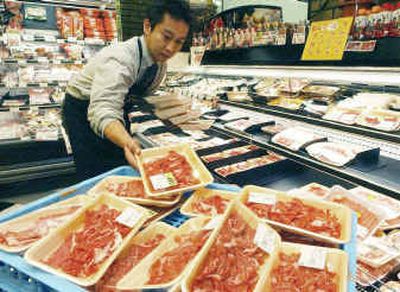High-stakes discussion

WASHINGTON — In a break from its steadfast ban on U.S. beef because of mad cow disease, Japan is moving toward allowing a resumption of imports if American officials can guarantee it’s from cattle no older than 20 months at slaughter.
American beef industry officials expect President Bush and Japanese Prime Minister Junichiro Koizumi to discuss the Japanese ban today when both leaders will be in New York for the U.N. General Assembly’s annual meeting.
A Japanese food safety panel opened the way for a shift in government policy earlier this month. It said mad cow tests on animals younger than 20 months could be eliminated without raising the risk of giving people a related rare but fatal disease, variant Creutzfeldt-Jakob disease.
U.S. agriculture officials refused to predict where the change in Japanese policy might lead but beef industry leaders said they consider it a step toward reopening the Japanese market to exports from the United States.
“Hopefully, we will end up at a point where we offer something we can verify, and they accept something that is equivalent to their system,” said Lynn Heinze, a spokesman for the U.S. Meat Export Federation, a Denver-based trade group.
There are still hurdles to be cleared before the United States again can ship meat to its former top-dollar export customer.
Japan had led the world in U.S. beef purchases, at $1.2 billion, before the discovery in December 2003 of mad cow disease in a Holstein cow in Washington state. Japan had accounted for 37 percent of the total value of U.S. beef exports, said Dave Weaber, director of research at Cattle-Fax, a research and market analysis firm in Centennial, Colo.
Upon discovery of the first U.S. case of mad cow, Tokyo immediately cut off U.S. exports and demanded that every American head of cattle destined for Japanese consumption be tested for the disease. Japan has used that standard for its domestic slaughter and since 2001 has confirmed 12 cases of mad cow disease, also known as bovine spongiform encephalopathy, or BSE.
U.S. officials have balked at blanket testing of all cattle, saying it’s too expensive and unnecessary. In addition, they say the tests are reliable only on cattle 30 months old or older. Japan, however, has reported finding BSE in two younger animals — one 21 months old and the other 23 months old.
Most U.S. fed cattle are slaughtered before they reach 21 months, according to industry officials. They acknowledge that for exports to Japan to resume, the two governments would have to agree on measures to assure that beef bound for Japan is from cattle no older than 20 months.
The Agriculture Department’s beef grading system is focused on meat quality, not age, said William Sessions, deputy administrator of the department’s Agricultural Marketing Service.
Age is one factor in beef quality — younger animals have more tender meat — but inspectors generally judge age by indirect measures, such as the stage of development of teeth and skeletal bones.
Tracking cattle from birth is easier in Japan, which has about 4.5 million head in the meat and dairy industries, Sato said. The United States has about 96 million head.
Some U.S. animals do have proof of age. Extensive records are kept on cattle raised for natural or organic foods markets, for instance, so meat buyers can be assured that the animals had few or no antibiotics or artificial growth hormones.